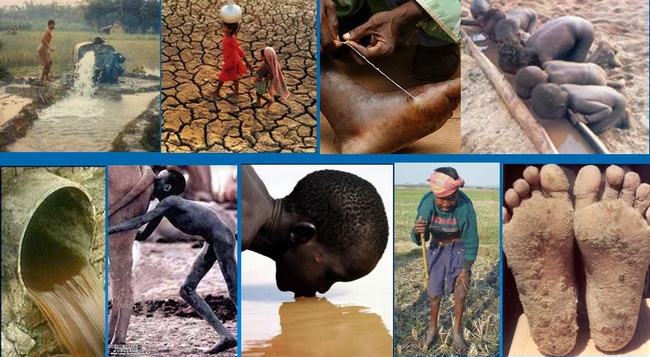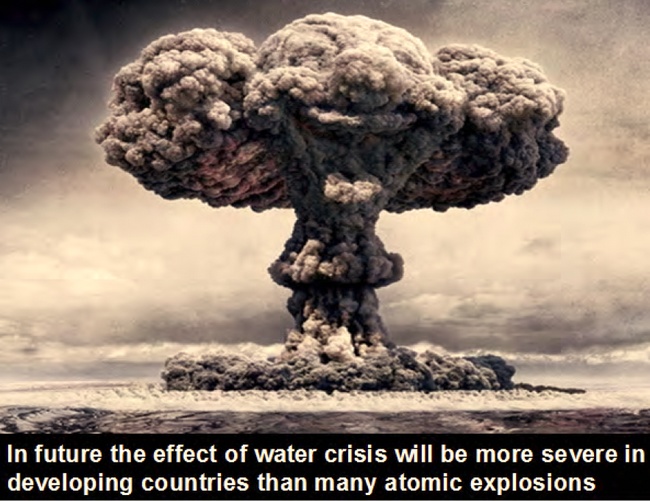|
Freshwater Scarcity:
quantity, Quality, Food Security,
Health Effects and Management issues Mainly in Developing Countries
By: Dipankar Chakraborti & Bhaskar Das*
Most of the Holy Books wrote about the divinity of water and considered water as the elixir of life. Water is incomparable. The Holy Koran says water is most Gracious, most Merciful and God does not love the water wasters.

Over the past decades, it has gradually become evident to those dealing with water management that there is going to be a chronic crisis in the water world. Until 1940, drinking water in most of the developing countries meant water from rivers, ponds, dug wells, lakes and rainwater, except in a few major cities. Between 1950 & 1970 many developing countries promoted a green revolution using chemicals to cope with the population growth. The population increased unabated, poor sanitation continued; a large number of factories produced synthetic chemicals, dyes mushroomed. Waste generated from their activities and washings was released in the water and in the soil. Washings from agricultural fields rich in fertilizers, pesticides, insecticides, herbicides and other chemicals made traditional sources of drinking water unfit for drinking. Even the holy Ganges water once used as a source of drinking water in India was declared highly polluted due to discharge of municipal wastes and wastes from thousands of small and big factories. Water borne diseases increased because of the amplified presence of pathogens in the drinking water. Due to the rapid increase of the population, more food hence more water for irrigation and domestic purpose was required but both its quality and quantity deteriorated. In this scenario it was proposed that the underground water from tube wells should be used as drinking water source as it would be relatively free from pathogens, and groundwater, the biggest source of fresh water in nature was also recommended for agricultural irrigation.
This underground water could bring a green revolution and many developing countries, like India and Bangladesh became self sufficient in food production. But during the last 20 years it has been found that ground water in many developing countries is arsenic / fluoride contaminated. The area and population of Ganga-Meghna-Brahmaputra flood plain (GMB-Plain) is about 600,000 sq. km. and over 500 million respectively. In India and Bangladesh (GMB-Plain) at present more than 100 million people are potentially at risk from groundwater arsenic contamination above the WHO guideline value (10 �g/L). In India alone above 62.5 million people are suffering from fluorosis. In general the drinking water quality of developing countries is pernicious. This is reflected by the high DALYs (Disability Adjusted Life Years) value (16%+). At present water scarcity exists all over the world. It has been estimated that by 2015 all countries with exception of Canada and Scandinavian countries will suffer water shortage in at least a part of their territory. Developing countries will be more affected by water scarcity. At present 1 billion people (out of present 6.5 billion world�s population) from developing countries lack enough water to meet their minimum water demand. �Fierce competition for fresh water may well become a source of conflict & wars in the future.�( Kofi Annan, March 2001). There are five �hot spots� of water dispute. These are the Aral sea region, the Jordan, the Nile, the Ganges and the Tigris-Euphrates. The population of these regions is expected to increase by 30 % by 2025.
It is the common opinion of all the experts working on agriculture field that one of the main factors limiting future food production will be water. The question that is raised, is whether there will be enough water for the food production for almost 8 billion people on earth by 2025. It is estimated that a population of 3 billions in 1960 doubled to 6 billion in 1999 and at present 250 million hectares? are irrigated worldwide, nearly 5 times more than at the beginning of the 20th century. The total food demand is expected to almost double in the coming 10 years. We can not increase our existing land areas and the water quantity that we have on earth is insufficient to satisfy the need of our increasing population, which has grown from 2000 in 7000 BC to the present 6.5 billion and is expected to be 8 billion by 2025. Hence the crux of the problem is that we are forced to share the same fixed quantity of land and water with more people. Due to the increasing population a rapid increase in water demand started for agriculture, household and in industry. To which extent the water scarcity will jeopardize food security remains a big question. Water scarcity will obviously deteriorate the quality of water and increase diseases due to water contamination. From the present trend of deterioration it appears that the poor people of the developing countries will be the most severely affected. The world is more concerned about food security, but the health effects of the poor people in developing countries will be devastating due to ingestion of contaminated water and food both pathogenically and chemically.
The importance of Environmental Demand for Water (EDW) has only been recently realized. Water is integrally linked to the health of the environment. In order to ensure the health of the environment we need to keep some percentage of our available water ( e.g swamp water) which under no circumstance can be used for domestic, agricultural and industrial purposes. For poor people of many developing countries where they can not get a square meal, this concept EDW is meaningless. A mother, who is considered as a symbol a love and affection, is at times driven to sell her child because of hunger.
It is to be noted:
-
The earth�s total water supply (approx. 1.4 billion cubic kilometer) is finite and will remain the same as it was at its creation. Out of this total water 97.4% is sea water and 2.6% fresh water. Out of this 2.6% fresh water (34,000 million cubic kilometer) only 11,000 cubic kilometer i.e., 0.77 % is available fresh water and the remaining fresh water is locked in ice-cap, permafrost and in areas not accessible.
- The world�s population increased 300% in 20th century and the use of water increased 700%
- Water use is expected to increase 50% over 2005 level to 2035.
- The water crisis would be triggered due to unexposed phenomena like drought, ENSO, EL-NINO.
- In developing countries the average crop yield will decline from 1.9% per year to 1.2% per year.
- Fierce competition for fresh water may well become a source of conflict & wars in the future

*School of Environmental Studies, Jadavpur
University, Kolkata-700032
�
|